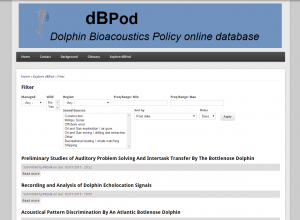Dolphin Bioacoustics
Heather Spence, Psychology
NML Award: The New Media Lab Digital Dissertation Award (April 2015)

This project is about the effects of anthropogenic (human-generated) noise on dolphin behavior and physiology. Humans are very visually oriented, but marine animals live in a world of sound. In the ocean, light is absorbed quickly but sound travels far and four times faster than in air. Disruption of the underwater soundscape can have profound effects. Examining the dynamics of the soundscape requires transforming sounds in different ways for analysis and presentation of results. Various characteristics of the sounds can be obscured or highlighted depending on the type of acoustic or visual transformation. One way to do this is through visual graphs (spectrograms). I am analyzing video and audio through spectrograms and other transformation methods to better measure the effects of anthropogenic noise on dolphin phonation, behavior and physiology.
Additionally, in an interactive website/searchable database “dBPod: Dolphin Bioacoustics Policy Online Database,” I am compiling existing documents relating to policies and standard practices of noise exposure and monitoring for both managed and wild dolphin populations. Included documents may be about public events, veterinary exams, behavioral training and other activities, as well as shipping and marine reserve policies. I am also providing information and synthesis that puts certain policies and practices in the context of what is known about the short and long-term effects of anthropogenic noise on dolphin physiology and behavior. This includes comparing timing and rhythm of sounds to timing and rhythm of dolphin responses. I highlight areas of further study that would help to inform policy and practice. This database resource is needed for anyone interested in dolphin welfare and marine sounds, and facilitates moving the discussion forward by making the information accessible.
For content management of the database, I am using Drupal, which has a flexible, modular structure suited for the complexity of this project. The options for creating taxonomies within Drupal enable me to organize the documents with multiple layers of tags that are searchable in a variety of ways. This is important for how users will interact with the database and for them to be able to find information and notice patterns.

